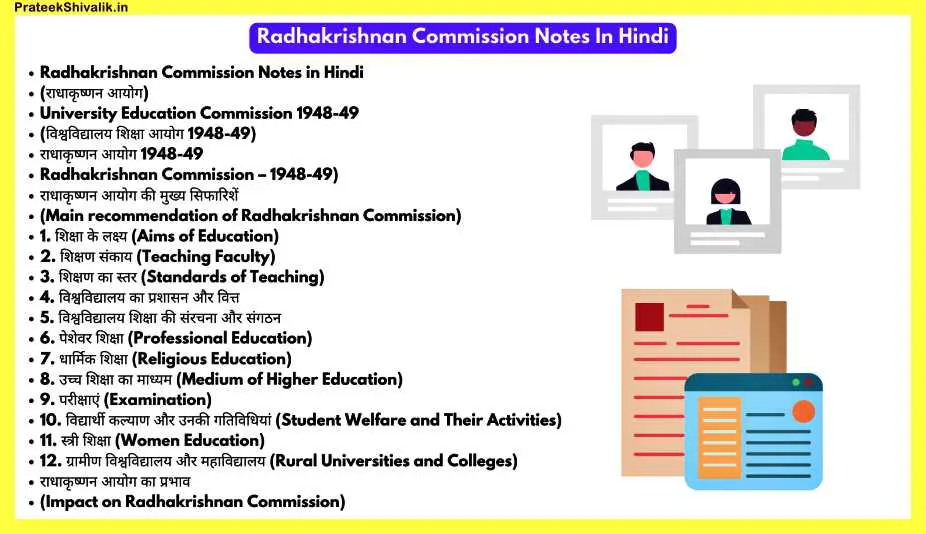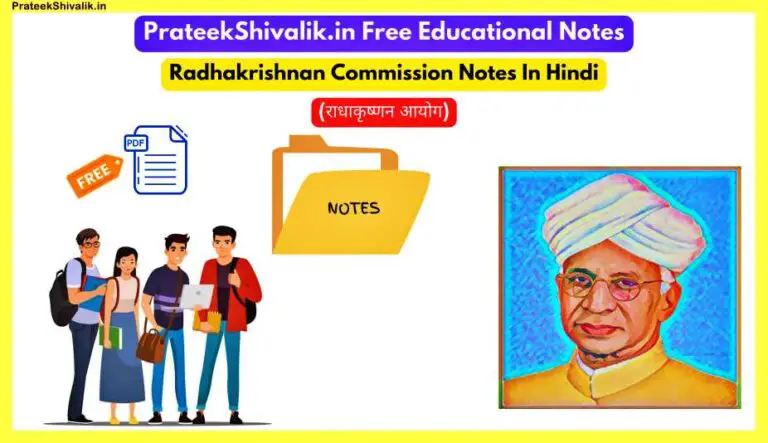Radhakrishnan Commission Notes in Hindi
(राधाकृष्णन आयोग)
आज हम आपको (Radhakrishnan Commission) के सम्पूर्ण नोट्स देने जा रहे हैं | Radhakrishnan Commission Notes in Hindi, (राधाकृष्णन आयोग / विश्वविद्यालय शिक्षा आयोग 1948-49) के नोट्स पढ़कर आप अपना कोई भी टीचिंग एग्जाम पास कर सकते हैं | तो चलिए जानते हैं इसके बारे में बिना किसी देरी के |
University Education Commission 1948-49
(विश्वविद्यालय शिक्षा आयोग 1948-49)
इसको Radhakrishnan Commission या राधाकृष्णन आयोग इसलिए कहा जाता था | क्योंकि इसके जो चेयर पर्सन थे | वह हमारे पहले (Vice President) उप राष्ट्रियपति और दूसरे राष्ट्रियपति (President) रहे थे | डॉ. सर्वपल्ली राधाकृष्णन इसके अध्यक्ष थे, इसीलिए इस आयोग को इसी नाम से भी जाना जाता है | और इसे विश्वविद्यालय शिक्षा आयोग या विश्वविद्यालय शिक्षा आयोग इसलिए कहा जाता है क्योंकि इसका काम विश्वविद्यालय स्तर की शिक्षा से संबंधित शोध करना और इसकी समस्याओं का पता लगाना है और उन समस्याओं को कैसे दूर किया जा सकता है, इस संबंध में सुझाव देना, तो इसीलिए इसे विश्वविद्यालय शिक्षा आयोग कहा जाता है। और इस आयोग में 10 सदस्य थे |
राधाकृष्णन आयोग 1948-49
Radhakrishnan Commission – 1948-49)
- यह स्वतंत्र भारत का पहला शिक्षा आयोग था । (It was the first education commission of independent India.
- इसे विश्वविद्यालय शिक्षा आयोग भी कहा जाता है क्योंकि इसकी नियुक्ति विश्वविद्यालय स्तर की शिक्षा व्यवस्था, संरचना की जाँच करना और तत्कालीन समस्याओं का पता लगाकर इसके संदर्भ में भारत सरकार को आवश्यक सुझाव देना था। (This is also called the University Education Commission because it did its research at the university level and gave necessary suggestions to the Government of India in its context.)
- यह आयोग 4 नवंबर, 1948 को नियुक्त किया गया था। (The commission was appointed on November 4, 1948.)
- इस आयोग ने 25 अगस्त, 1949 को अपनी रिपोर्ट भारत सरकार को सौंप दी । (It has submitted its report to the Government of India on August 25, 1949.)
- डॉ. राधाकृष्णन इस आयोग के अध्यक्ष थे । (Dr. Radhakrishnan was the chairman of this commission.)
- इसलिए इसे राधाकृष्णन आयोग के रूप में भी जाना जाता है। (So it is also known as Radhakrishnan Commission.)
- जाँच के विषय (Terms of References)
- तत्कालीन विश्वविद्यालयों का अध्ययन करना और उनकी समस्याओं का पता लगाना । (To study the contemporary universities and find out their problems.)
- प्रशासन और वित्त के बारे में सुझाव देना । (To give suggestions about administration and finance.)
- उच्च शिक्षा के लक्ष्यों को निर्धारित करना । (To determine the aims of higher education.)
- उच्च शिक्षा के शिक्षण स्तर को बढ़ाना । (To raise the teaching standard of higher education.)
- विद्यार्थियों के कल्याण के लिए योजनाएं प्रस्तुत करना । (To present plans for the welfare of students).
- विद्यार्थियों में उपस्थित अनुशासनहीनता का समाधान खोजना । (To find solution about indiscipline among the students.)
- शिक्षकों की नियुक्ति, वेतनमान और सेवा शर्तों के बारे में सुझाव देना । (To give suggestion regarding appointment, pay scale and service conditions of the teachers.)
- शिक्षा के माध्यम, अवधि और पाठ्यचर्या के बारे में सुझाव प्रस्तुत करना । (To submit suggestions regarding medium, duration and curriculum of education.)
राधाकृष्णन आयोग की मुख्य सिफारिशें
(Main recommendation of Radhakrishnan Commission)
- शिक्षा के लक्ष्य (Aims of Education)
- शिक्षण संकाय (Teaching faculty)
- शिक्षण का स्तर (Standards of teaching)
- विश्वविद्यालय का प्रशासन और वित्त (Administration and finance of the universities)
- विश्वविद्यालय शिक्षा की संरचना और संगठन (Organization and structure of university education)
- पेशेवर शिक्षा (Professional Education)
- धार्मिक शिक्षा (Religious education)
- उच्च शिक्षा का माध्यम (Medium of higher education)
- परीक्षाएं (Examination)
- विद्यार्थी कल्याण और उनकी गतिविधियां (Student welfare and their activities)
- स्त्री शिक्षा (Women education)
- ग्रामीण विश्वविद्यालय और महाविद्यालय (Rural universities and colleges)

1. शिक्षा के लक्ष्य (Aims of Education)
- लोकतंत्र के लिए प्रशिक्षित करना (To train for democracy)
- आत्म-विकास के लिए प्रशिक्षण देना (To train for self-development)
- वर्तमान और साथ ही अतीत की समझ विकसित करना । (To develop an understanding of the present as well as of the past.)
- व्यावसायिक और पेशेवर प्रशिक्षण प्रदान करना । (To impart vocational and professional training.)
- अपनी सांस्कृतिक विरासत के उत्थान के लिए विद्यार्थियों को इससे परिचित कराना । (To acquaint with a cultural heritage for its regeneration.)
2. शिक्षण संकाय (Teaching Faculty)
- आयोग के अनुसार शिक्षकों को चार श्रेणियों में विभाजित किया जाए- प्रोफेसर, पाठक, व्याख्याता, और प्रशिक्षक । (There would be four categories of teachers Professors, Readers, Lecturers, and Instructors.)
- योग्यता के आधार पर ही एक श्रेणी से दूसरे में पदोन्नति की जाए । (Promotion from one category to another to be solely on grounds of merit.)
- आयोग ने चारों श्रेणियों के शिक्षकों के लिए उच्च वेतन और बेहतर सेवा शर्तों की सिफारिश की। (The commission recommended higher salaries and better service conditions for the four categories of teachers.)
- शिक्षण कार्य सप्ताह में 18 घंटे से अधिक नहीं दिया जाना चाहिए । (The teaching work should not be given more than 18 hours a week.
- शिक्षकों को अध्ययन के लिए एक बार में एक वर्ष का और सम्पूर्ण सेवाकाल में 3 वर्ष का अवकाश दिया जाना चाहिए । (Teachers should be given one year left at a time and 3 years leave in full service for study.)
- सेवा से अवकाश की उम्र 60 से बढ़ाकर 64 वर्ष कर दी जाए । (Retirement age to be increased from 60 to 64 years.)
3. शिक्षण का स्तर (Standards of Teaching)
- विश्वविद्यालयों में 3000 से अधिक और उनसे सम्बंधित महाविद्यालयों में 1500 से अधिक विद्यार्थियों की संख्यां नहीं होनी चाहिए । (There should not be more than 3000 students in the universities and not be more than 1500 students in their affiliated colleges.)
- विश्वविद्यालयों और महाविद्यालयों में उन्ही विद्यार्थियों को प्रवेश देना चाहिए जो 12 वर्ष की विद्यालयी शिक्षा प्राप्त कर चुके हैं। (Students who have completed 12 years of study at a school should be admitted in the universities and colleges.)
- कार्य दिवसों की संख्या- एक साल में 180 (परीक्षा के दिनों को छोड़कर) । (No. of working days-180 in a year (excluding of examination days.)
- अध्ययन के किसी भी कोर्स के लिए पाठ्यपुस्तक निर्धारित नहीं की जानी चाहिए (The textbook should not be prescribed for any course of study.)
- सांयकालीन कक्षाओं का आरम्भ किया जाना चाहिए । (Evening classes should be started.)
- परीक्षाओं के स्तर को उठाने के लिए प्रथम, द्वितीय और तृतीय श्रेणी के लिए न्यूनतम प्राप्तांक क्रमशः 70, 55 और 40 प्रतिशत होने चाहिए । (To raise the level of examinations, the minimum score for a first, second, and third grade should be 70, 55, and 40 percent.)
4. विश्वविद्यालय का प्रशासन और वित्त
- (Administration and Finance of the Universities) उच्च शिक्षा को समवर्ती सूची में रखा जाना चाहिए । केंद्र और राज्य सरकारों की इसमें साझी जिम्मेदारी निभानी चाहिए ।
- (Higher education should be kept in the concurrent list. Central and state governments should play a shared responsibility.) शिक्षा से सम्बंधित नीतियाँ बनाने का कार्य केंद्र सरकार का होगा और राज्य सरकार उन नीतियों को अपने राज्यों में लागू करेंगी।
- (The central government will have to make policies related to education and the state government will implement those policies in their states.)
- विश्वविद्यालयों में एकरूपता लाने और महाविद्यालयों और विश्वविद्यालयों को अनुदान प्रदान करने के लिए विश्विद्यालय अनुदान आयोग की स्थापना की जानी चाहिए । (Establishment of University Grants Commission to bring about uniformity in the works of the universities and to provide grants to colleges and universities.)
5. विश्वविद्यालय शिक्षा की संरचना और संगठन
- (Organization and structure of University Education) उच्च शिक्षा तीन स्तरों पर आयोजित की जानी चाहिए – स्नातक (3 वर्ष), स्नातकोत्तर (2 वर्ष) और शोध (न्यूनतम 2 वर्ष) ।
- (Higher education should be organized at three levels- graduation (3 years), post-graduation (2 years), and research (minimum 2 years). उच्च शिक्षा को 3 श्रेणियों में बांटा जाना चाहिए- कला, विज्ञान, व्यावसायिक और तकनीकी ।
- (Higher education should be grouped into 3 categories – art, science, vocational, and technical.) कला, विज्ञान, व्यावसायिक और तकनीकी विषयों के लिए विश्वविद्यालयों में अलग-अलग विभाग खोले जाने चाहिए।
- (Separate departments should be opened in the universities for art, science, vocational, and technical subjects.) कृषि, वाणिज्य, इंजीनियरिंग, प्रौद्योगिकी, चिकित्सा और शिक्षक प्रशिक्षण के लिए स्वतंत्र संबद्ध कॉलेजों की स्थापना की जानी चाहिए ।
- (Independent affiliated colleges should be established for agriculture, commerce, engineering, technology, medical, and teacher training.)
6. पेशेवर शिक्षा (Professional Education)
विश्वविद्यालय शिक्षा आयोग ने इसे छह श्रेणियों में बांटा है जो नीचे दिए गए हैं:
(The university education commission has divided it into the six category:)
- शिक्षक शिक्षा (Teacher Education)
- कृषि शिक्षा (Agriculture Education)
- वाणिज्य शिक्षा (Commerce Education)
- इंजीनियरिंग और तकनीकी शिक्षा (Engineering and Technical Education)
- चिकित्सा शिक्षा (Medical Education)
- कानूनी शिक्षा (Education of Law)
7. धार्मिक शिक्षा (Religious Education)
- धार्मिक शिक्षा का मुख्य उद्देश्य लोगों में धार्मिक कट्टरता को खत्म करना और सभी धर्मों के प्रति सकारात्मक सोच विकसित करना था । (The main objective of religious education was to eliminate religious fanaticism in people and develop positive thinking towards all religions.)
- डिग्री कोर्स के प्रथम वर्ष में विद्यार्थियों को बुद्ध, कन्फ्यूशियस, सुकरात, यीशु, शंकर, मोहम्मद, कबीर, नानक, गांधी आदि विश्व के प्रसिद्ध महापुरुषों के जीवन और उनके कार्यों के विषय में विद्यार्थियों को बताया जाना चाहिए । (In the first year of a degree course, the lives of great religious leaders like Buddha, Confucius, Zoroaster, Socrates, Jesus, Shankar, Mohammed, Kabir, Nanak, Gandhi, etc. be taught.)
- डिग्री कोर्स के दूसरे वर्ष में, विश्व के प्रसिद्ध धार्मिक ग्रंथों में से सार्वभौमिक महत्त्व के कुछ चुने हुए भाग पढ़ाएँ जाने चाहिए। (In the second year, the selection of some universal characters from the scriptures of the world be studied.)
- डिग्री कोर्स के तीसरे वर्ष में, धर्म-दर्शन की मुख्य समस्याएं पढ़ाई जानी चाहिए। (In the third year, the central problems of the philosophy of religion are considered.)
8. उच्च शिक्षा का माध्यम (Medium of Higher Education)
- उच्च शिक्षा का माध्यम अंग्रेजी की वजाय प्रादेशिक भाषाएँ होनी चाहिए। (The medium of instruction for higher education should be regional language)
- अंग्रेजी को जल्दी से जल्दी एक भारतीय भाषा से बदल दिया जाना चाहिए । (English be replaced as early as possible by an Indian language)
- संघीय भाषा हिंदी को शिक्षा का माध्यम बनाने की स्वतंत्रता होनी चाहिए । (Federal language Hindi should have the freedom to make medium of instruction)
- उच्च विद्यालयों और विश्वविद्यालयों में अंग्रेजी शिक्षा को बनाये रखना चाहिए । (English be studied in High Schools and in Universities)
9. परीक्षाएं (Examination)
- आयोग ने विश्वविद्यालयों की परीक्षा-प्रणाली को सबसे अधिक दोषपूर्ण पाया और इस सम्बन्ध में सुझाव दिए । (The commission found the examination system of the universities to be the most faulty and gave suggestions in this regard.)
- तीन वर्षीय डिग्री कोर्स की परीक्षा 3 वर्ष पश्चात् न लेकर प्रत्येक वर्ष के अंत में ली जानी चाहिए। (The three-year degree course examination should be taken at the end of each year, not after 3 years.)
- विद्यार्थियों की प्रगति का मूल्यांकन करने के लिए वस्तुनिष्ठ प्रगति परीक्षाओं का सेट तैयार किया जाना चाहिए । (A set of objective progress tests should be prepared to evaluate the progress of students.)
- परीक्षाओं के स्तर को उठाने के लिए प्रथम, द्वितीय और तृतीय श्रेणी के लिए न्यूनतम प्राप्तांक क्रमशः 70, 55 और 40 प्रतिशत होने चाहिए। (To raise the level of examinations, the minimum score for a first, second, and third grade should be 70, 55, and 40 percent.)
- विश्वविद्यालयों की परीक्षाओं में रियायती अंक देने की व्यवस्था को समाप्त किया जाना चाहिए । (Grace marks must be eliminated in the examinations of universities.)
10. विद्यार्थी कल्याण और उनकी गतिविधियां (Student Welfare and Their Activities)
- सभी विश्वविद्यालयों में चिकित्सा और स्वास्थ्य सेवाएं उपलब्ध होनी चाहिए । (All universities must have hospital and health services)
- गरीब विद्यार्थियों के लिए छात्रवृत्ति की व्यवस्था की जानी चाहिए । (Scholarships should be arranged for the poor students)
- दो वर्ष की शारीरिक शिक्षा सभी विद्यार्थियों के लिए अनिवार्य की जानी चाहिए। (Two years of physical education be required for all students)
- सभी महाविद्यालयों और विश्वविद्यालयों में विद्यार्थियों के लिए छात्रावास की सुविधा प्रदान की जानी चाहिए । (Hostel facilities should be provided for students in all colleges and universities.)
- विश्वविद्यालयों और कॉलेजों में छात्र संघ का गठन होना चाहिए लेकिन इसे राजनीति से दूर रखा जाना चाहिए । (Students union should be formed in the universities and colleges but they should be kept away from politics)
- प्रत्येक विश्वविद्यालय में एक विद्यार्थी कल्याण सलाहकार बोर्ड का गठन किया जाना चाहिए ताकि छात्र कल्याण कार्यक्रमों को तैयार और कार्यान्वित किया जा सके। (An advisory board of student welfare should be organized in every university to prepare and implement the student welfare programs.)
- विद्यार्थियों को स्वस्थ रखने के लिए खेल के मैदानों और व्यायामशालाओं की समुचित व्यवस्था की जानी चाहिए। (Proper arrangement of playgrounds and gymnasiums should be made to keep the students healthy.)
- सभी महाविद्यालयों और विश्वविद्यालयों में एन.सी.सी. की स्थापना की जानी चाहिए और विद्यार्थियों को उसका सदस्य बनने के लिए प्रोत्साहित किया जाना चाहिए । (NCC should be established in all colleges and universities and students should be encouraged to become its members)
11. स्त्री शिक्षा (Women Education)
- महिला शिक्षा के पाठ्यक्रम में गृह प्रबंधन, घरेलू अर्थशास्त्र और पोषण शामिल होना चाहिए । (The curriculum of women’s education should include home management, home economics, and nutrition.)
- महिलाओं की शिक्षा का मुख्य उद्देश्य उन्हें अच्छी माँ और अच्छी गृहिणी बनाना होना चाहिए । (The main aim of women’s education should be to make them good mothers and good housewives.)
12. ग्रामीण विश्वविद्यालय और महाविद्यालय (Rural Universities and Colleges)
- ग्रामीण शिक्षा के उद्देश्य के लिए ग्रामीण क्षेत्रों में ग्रामीण विश्वविद्यालयों को स्थापित किया जाना चाहिए। (For the purpose of rural education, there should be established rural universities in rural areas)
- एक ग्रामीण महाविद्यालय में विद्यार्थियों की संख्या 300 से ज्यादा नहीं होनी चाहिए । (A rural college should have the strength of not more than 300 students)
- ग्रामीण विश्वविद्यालयों में विद्यार्थियों की संख्या 2500 से अधिक नहीं होनी चाहिए । (The strength of rural universities should not be more than 2500 students)
- ग्रामीण विश्वविद्यालयों में अनुसंधान कार्यों की व्यवस्था की जानी चाहिए। (Research facilities should be organized in rural universities)
राधाकृष्णन आयोग का प्रभाव
(Impact on Radhakrishnan Commission)
- 1953 में यूजीसी का गठन हुआ और 1956 में उच्च शिक्षा के उत्थान के लिए इसे स्वायत्त दर्जा दिया गया। (In 1953, UGC was formed and in 1956 it was given an autonomous status for the upliftment of higher education.)
- 1954 में सरकार ने एक ग्रामीण उच्च शिक्षा समिति की स्थापना की और ग्रामीण शिक्षा का आयोजन करने की जिम्मेदारी दी । (In 1954, the government established a rural higher education committee and gave it the responsibility to organize rural education.)
- इस आयोग के सुझाव पर कृषि, वाणिज्य, इंजीनियरिंग, चिकित्सा, कानून और शिक्षक प्रशिक्षण के स्वतंत्र महाविद्यालयों की स्थापना हुई । (The independent colleges were established for agriculture, commerce, engineering, medical, law, and teacher training.)
- इस आयोग के सुझाव पर अधिकांश विश्वविद्यालयों ने 3 वर्ष का डिग्री पाठ्यक्रम, दो वर्ष का स्नातकोत्तर पाठ्यक्रम और अनुसंधान के लिए न्यूनतम 2 वर्ष की शुरुआत की। (Most of the universities introduced 3 years degree courses, two-year post graduate course, and a minimum of 2 years for research.)
- विश्वविद्यालयों और महाविद्यलयों में एनसीसी (1948) और एनएसएस (1969) की शुरुआत की गई । (NCC (1948) and NSS (1969) were promoted in the universities and colleges.)
- विश्वविद्यालय और महाविद्यालयों के शिक्षकों के वेतनमान बढ़ाये गए और उनकी सेवा की स्थिति में सुधार हुआ । (The pay scale of university and college teachers was raised and their service condition was improved.)
- विश्वविद्यालय और महाविद्यालयों में छात्र कल्याण कार्यक्रम (जैसे हॉस्टल, कैंटीन, चिकित्सा और स्वास्थ्य सुविधाएं आदि) शुरू हुई। (Student’s welfare program (hostels, canteen, medical and health facilities) began.)
Also Read:



